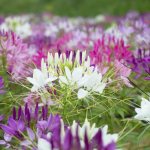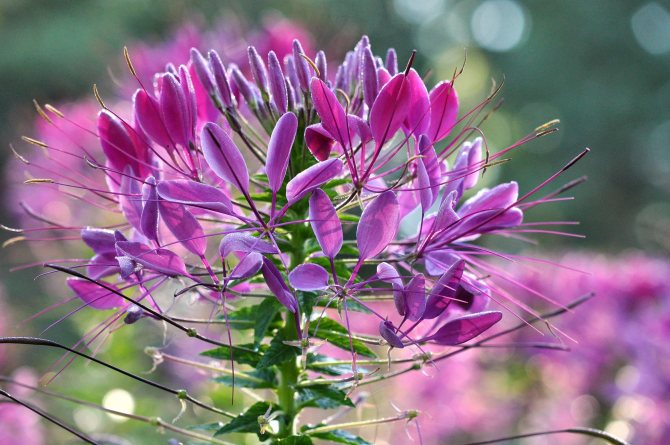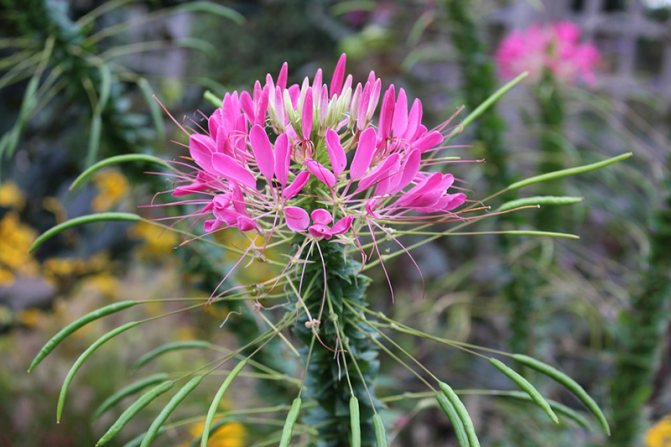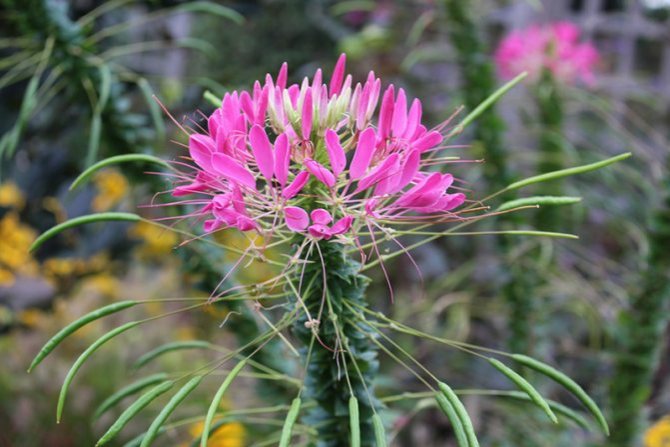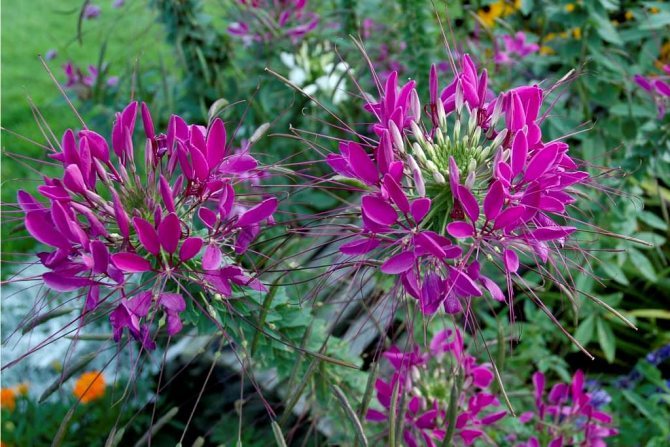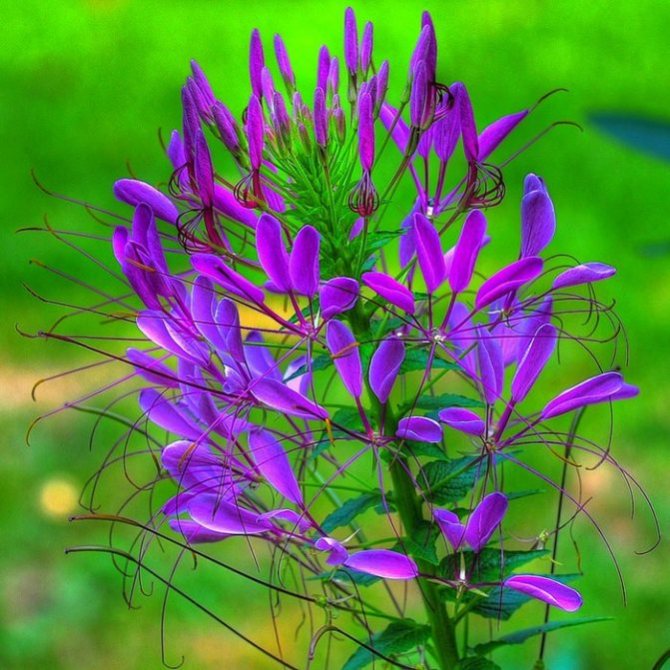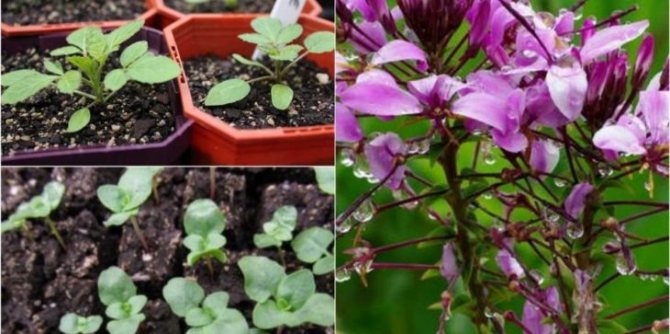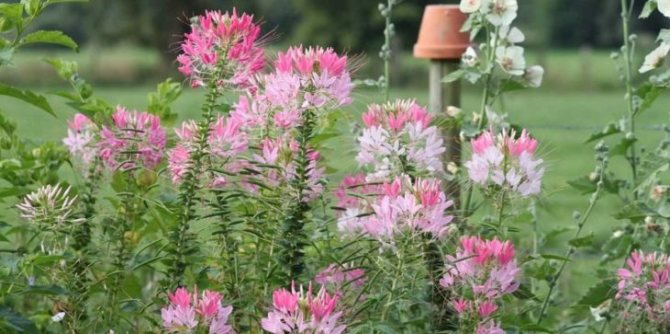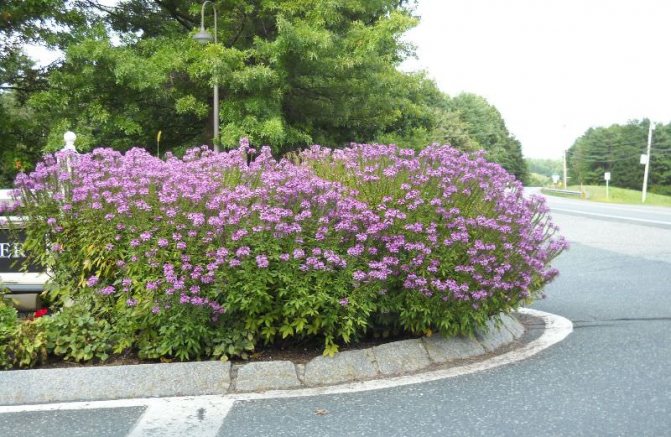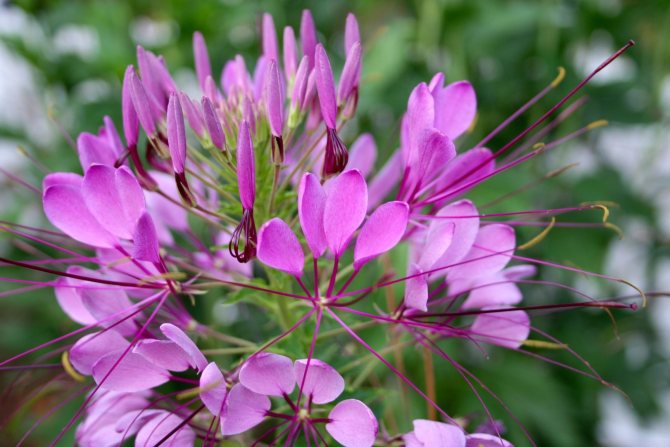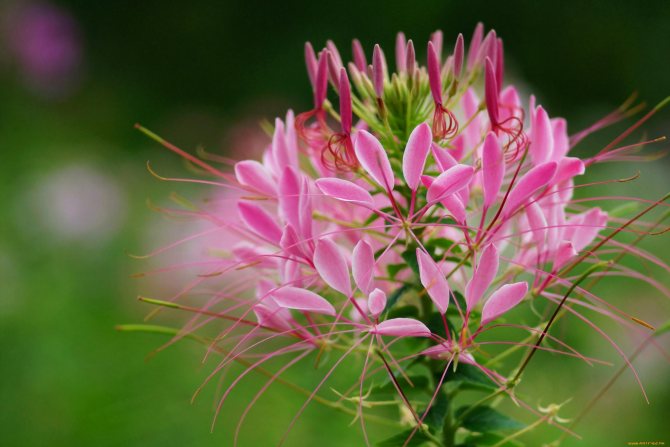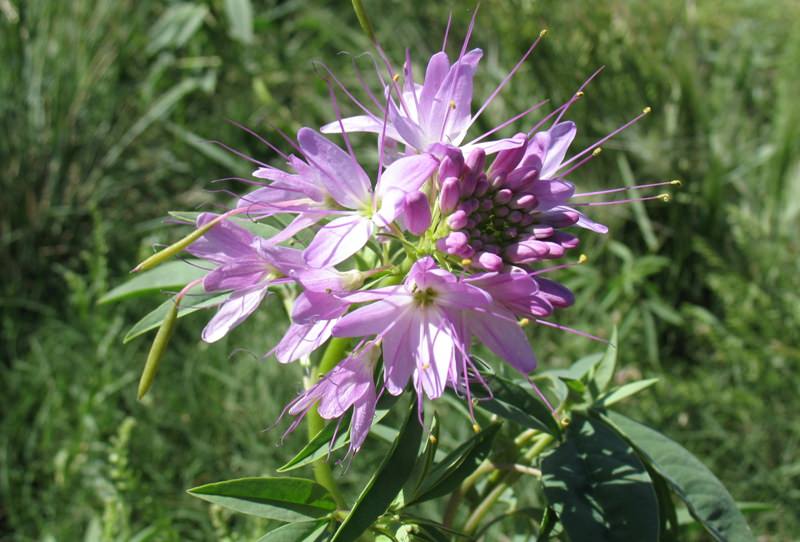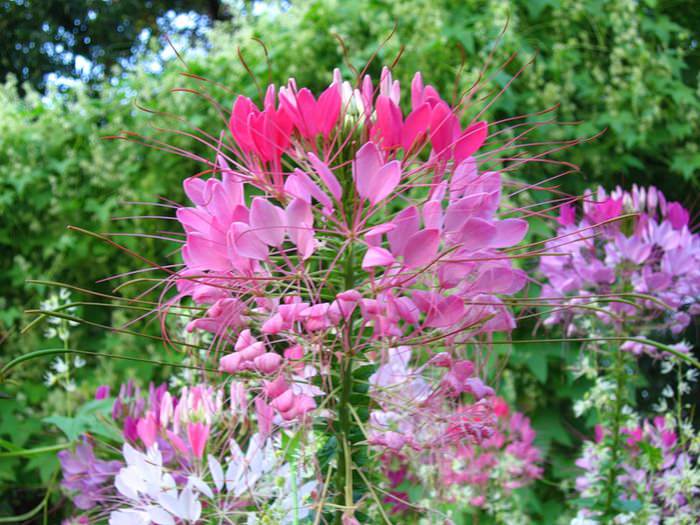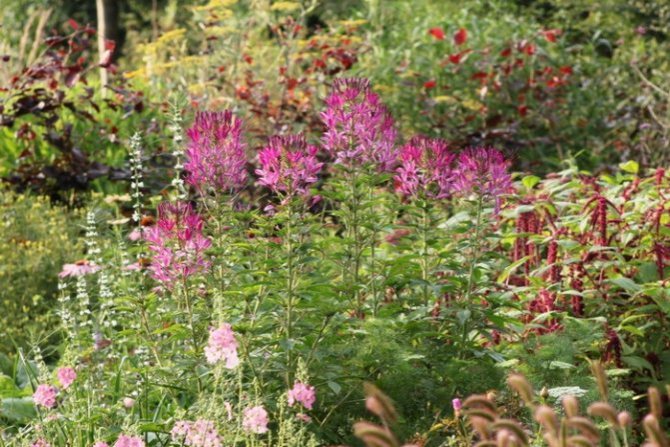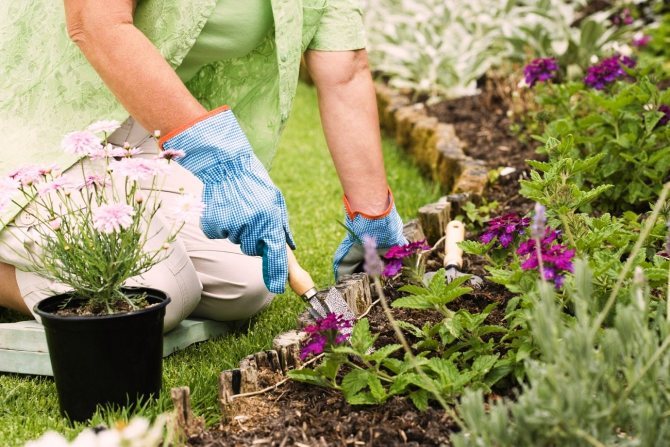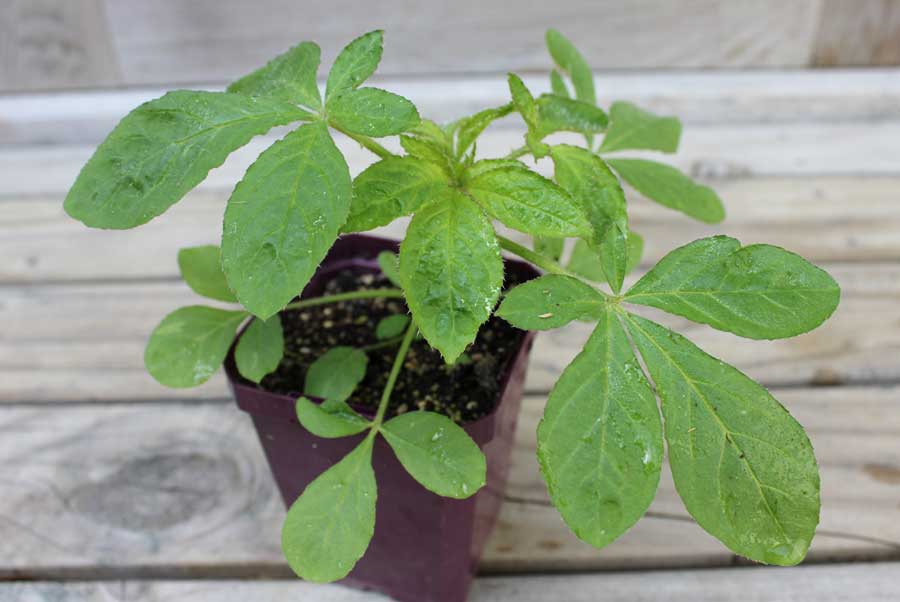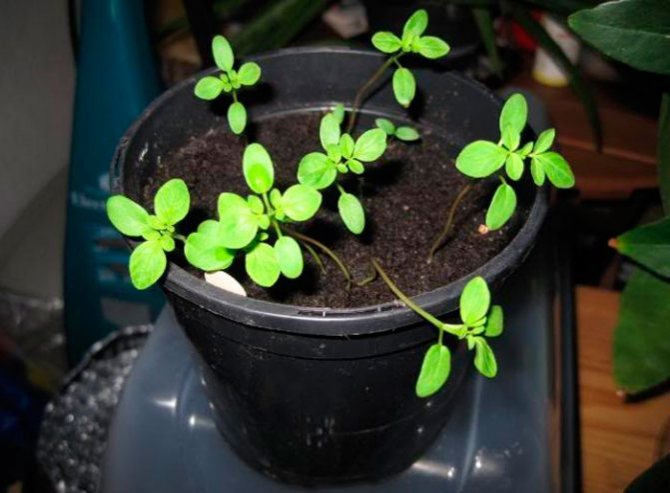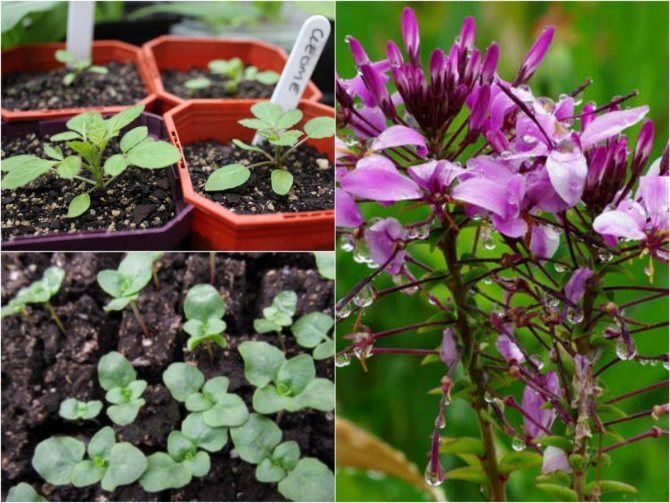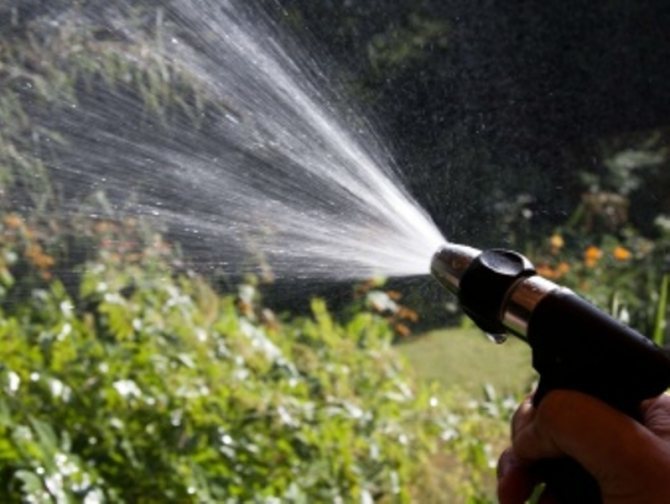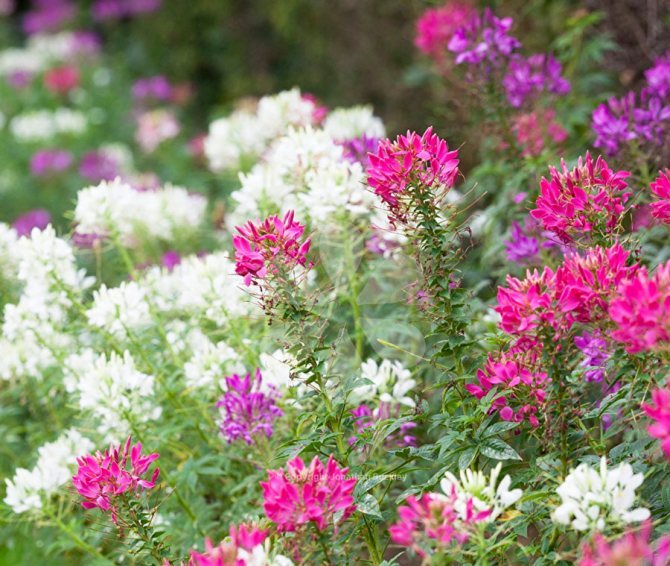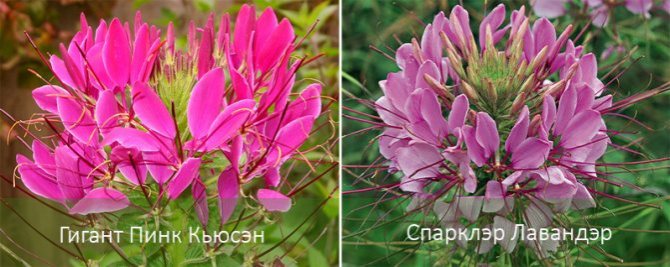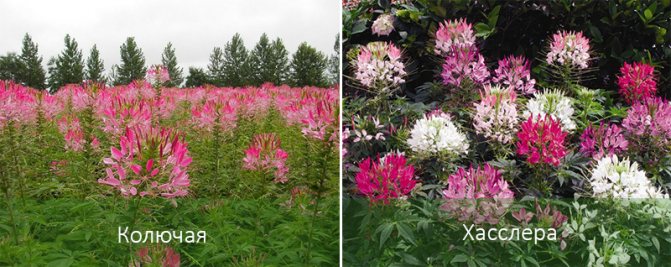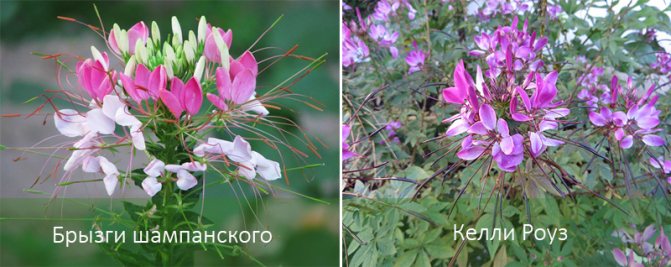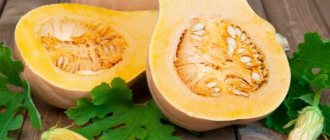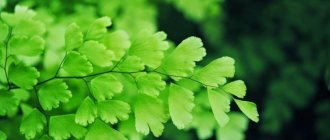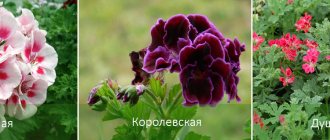- April 22, 2019
- Flowers
- Sergey Kostyuchenko Zhelyazkov
Cleoma is a plant that grows in warm climates. This plant attracts amateur gardeners with its interesting aroma and beauty. Cleoma stem height can reach one or one and a half meters. In our region, the culture grows like an annual plant, while many dream of decorating their flower bed with just such flowers. In order for cleoma to grow and please the eye, you need to know how to plant it from seeds and take care of it. In this article we will try to talk about the cleoma plant: growing from seeds, when to plant and how to care.
How to grow glue?

Although the plant is a guest from the tropical climate, in our region it grows well as an annual flower in the open field. In one season, the cleoma has time to germinate from the seed, reach maturity and discard fully viable seeds that can be planted again. The plant is unpretentious in care, and is resistant to diseases, as well as pests. In our country, a flower grows for one year, but at the same time seeds appear that can be planted in the next season. Also below is a photo of cleoma flowers.
Color classification
Cactus fruit: description of the species and their benefits and harms
Cleoma has two main varieties, but there are many more varieties. To date, botanists have more than 250 varieties. There are two types of glue on sale:
- cleoma Hassler;
- prickly cleoma.
They grow mainly in the countries of South America, and for the territory of Russia, separate varieties have been created that can adapt to environmental conditions, guaranteeing long flowering. These include:
| View | Varieties |
| Hassler | Splash of Champagne, Kelly Rose. |
| Prickly | Cherry Queen, Hellen Campbell, Rosakenigin, Pink Rose, Queen Rose, Violet Queen, Golden Sparkler, Giant Pink Kewsen, Sparkler Lavander. |
Some varieties and species are considered in more detail below.
Cleome Hassleriana
Cleoma of this species was brought to Russia, as already mentioned, from the countries of South Africa: Argentina, Paraguay and the eastern part of Brazil. It is an annual plant up to a meter high, with unique decorative characteristics. It has wide, spreading leaves of a rich green-emerald hue and lush inflorescences from delicate pastel to rich and bright shades of pink, lilac, purple. The flowering period ends with the ripening of the seed pods.
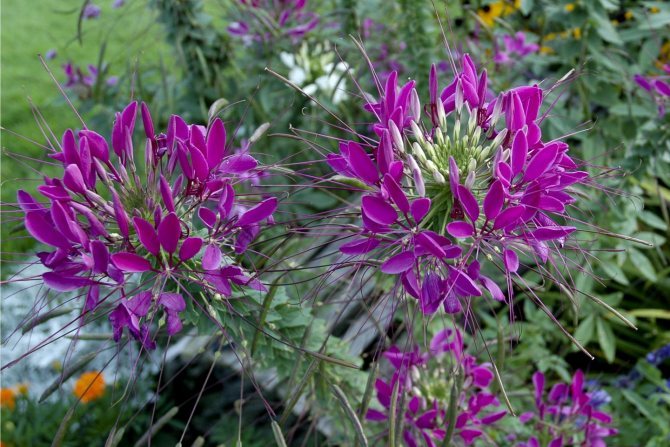

Hassler
Cleome Spinosa
Cleoma prickly is widely known among gardeners for its interesting, bizarre flowers. During the flowering period, they open, and the petals become long and thin, like spider legs, therefore there is another name among the people - the spider flower.
In addition, this type is considered the largest among the glue, its height often passes the 1 m mark.
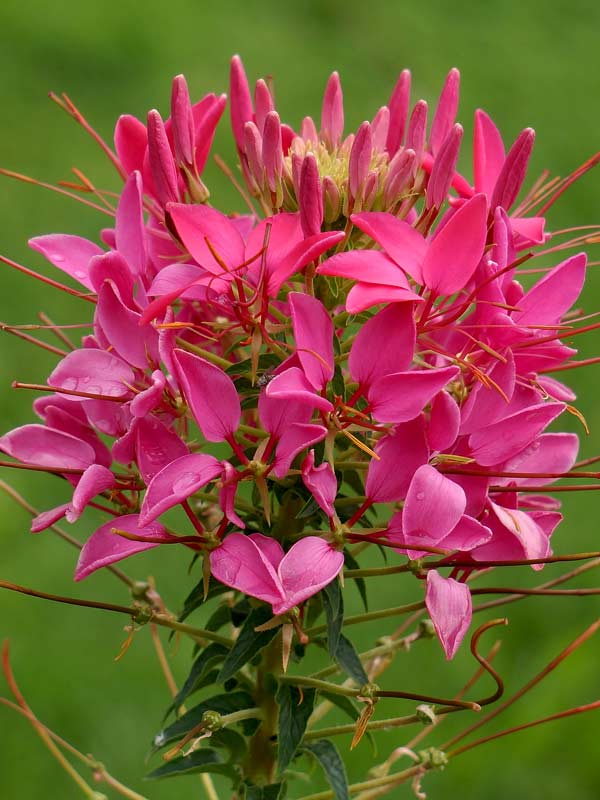

Prickly variety
Features of planting seeds for the winter
A plant from seeds is planted directly into the ground. As a rule, disembarkation takes place before winter or in spring. In order to get an early plant, you can plant seedlings.
How to grow glue from seeds in winter? Planting before winter does not require special seed preparation. Grooves up to two centimeters deep are made in the ground and sown evenly.It is not necessary to water the garden bed, as the seeds will lie in this form until the arrival of heat. After the spring sun warms up, moisture from the soil will get to the seeds, and they will begin to germinate.
Growing features
Self-cultivation of cleoma from seeds at home occurs in two ways: by seedling and sowing seeds directly to the beds.
Soil preparation and landing sites
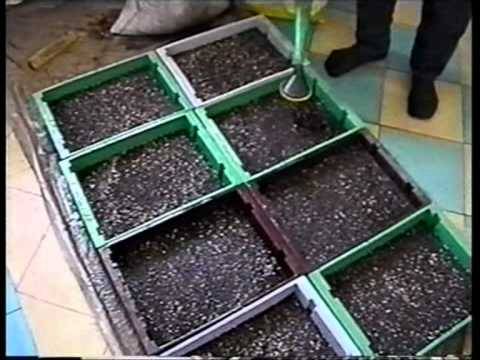

It doesn't matter if cleoma is grown by seedlings or sown directly on the garden bed, in any case, the soil and place are prepared for the flower. The plant loves a sunny area with non-swampy soil. It is better to choose a hill so that after the rain the water flows down and does not accumulate in puddles.
Before planting cleoma seedlings in the last days of April, the bed is dug onto a shovel bayonet. Weed roots are removed from the soil. Organic matter is used as fertilizer. Compost works best. In the absence of organic matter, replace with complex fertilizer at the rate of 2 tbsp. l. / 1 m2 of beds. The size of the flower bed for glue is calculated taking into account the planting scheme. A minimum of 50 cm of space is left between each plant for the growth of bushes.
The seeds of the glue flower can be sown even in autumn. The garden bed is prepared in a similar way. Sowing is carried out in rows. Excess plants are removed in the spring, observing a favorable planting scheme for bushes.
The nuances of growing seedlings
In cold regions, everyone is used to growing seedlings. Flowers are no exception. All that remains is to figure out when to sow the glue and how to do it. To get seedlings, you first need to collect seeds. When the cleoma inflorescences that have faded on the bushes turn into bolls, they are given time to dry. When crushing the pods, small brown-black grains are scattered. The seeds are collected in a bag and stored until spring.
Important! Cleoma reproduces poorly by self-seeding.
In early March, it is time to sow cleoma seeds for seedlings, but first the grains are prepared. For better germination, seeds are soaked in a growth stimulator. The drug is bought in a store or they resort to folk methods using the juice of aloe flower.
The soil mixture for cleoma is prepared from the calculation of two parts of compost and earth, plus one part of sand. Soil 15 cm thick is poured into a box, sprinkled with ash on top, grooves 1 cm deep are cut, where the seeds are immersed. From above, the grains are covered with loose humus. The box is covered with a transparent film, leaving warm until shoots appear. If the seeds have gone through the soaking process, they will sprout after 15 days.
When growing seedlings from cleoma seeds, it is required to provide the flower with maximum care at the initial stage. The procedure involves timely watering. It should be plentiful, but not frequent. Cleoma bushes love moist and loose soil without accumulating puddles. Several crystals of manganese are added to the irrigation water for disinfection.
Cleome seedlings provide good light. In the evening, they turn on artificial lighting. After the appearance of two adult leaves, the seedlings are dived, planting in separate containers. After 10 days, and then another two weeks later, nitrogen fertilizing is applied. When the cleoma has adapted and started to grow, artificial lighting of the seedlings is not required. Before planting on the garden bed, the plants are tempered by taking them outside or into a cool room.
Sowing seeds in the garden
Now let's look at how to grow glue from seeds without seedlings. Autumn is considered the optimal sowing time. The seeds will undergo a natural process of soaking and hardening before the onset of spring, and will give quick shoots in spring. Grooves with a depth of 1.5 cm are cut along the bed with fertilized soil. Cleoma grains are thrown in bulk. Sprinkle with earth on top and lay any organic insulation: grass, leaves, tops of garden crops. With the onset of spring, the shelter is removed, and after the emergence of seedlings, thinning is carried out.
Spring sowing of seeds is carried out at the end of frost. The procedure for preparing the beds, as well as further care, remain unchanged. Only the condition of the seeds differs. For sowing, use awakened grains that have passed the soaking stage. You can sow dry seeds, but then flowering will start late.
Planting seeds in the ground


If you decide to plant seeds in the spring, then the grooves made should be filled with water. It is recommended to plant a plant in spring in April or May, depending on climatic conditions. For rapid germination of the plant, it is recommended to treat the seeds with a growth stimulator. The seeds placed in the solution should stay in it for about fifteen hours.
When all the preparatory processes are completed, the seeds are placed in the soil to a depth of no more than three centimeters with a distance of about thirty cm between them. The seeds germinate rather slowly. Shoots germinate in the ground for about a month. You can speed up the growth process a little, cover the plant with plastic wrap. Above is a photo of cleoma flowers without film. After the first leaves appear on the seedlings, the plant must be transplanted. The distance between flowers should be at least sixty centimeters. The transplantation of flowers should not be delayed, young plants can easily tolerate a change in habitat.
Varieties that are very popular with gardeners
Thanks to breeders, many plant varieties have appeared in the world, differing from each other not only in appearance, but also in the way of care, as well as the flowering period. It is better for beginners to choose unpretentious specimens that are easy to plant. These include:
- Cherry Queen. With lilac and purple flowers. You can grow the plant in a pot or in open ground.
- Cleoma A splash of champagne. Has a pearl and pink color.
- Hellen Campbell, delighting with snow-white peduncles. It is called white cleoma.
- Rozakenigin with a delicate peach color.
- Pink Queen and Rose Queen reflecting all shades of pink.
- Golden Sparkler, pleasing with yellow flowers on a low bush.
- Giant Pink Kewsen. The flowers are large with a pink tint.
- Sparkler Lavender. Painted in a pale purple shade.
- Violet Queen with deep purple flowers.
Rose Handel (Handel) - features of planting and care
Planted cleoma in the garden looks great together with scented tobacco and other plants. It is tall, which is why it is often used to create hedges.
Interesting! The Queen line is very popular with gardeners, the line of which includes such varieties as the Cherry Queen, White Queen and others.
Cleoma. Seedling
Also, cleoma flowers are planted with seedlings. Thanks to this planting option, the flower begins to bloom earlier and is pleasing to the eye. To plant seedlings, you first need to prepare the soil. For good seedlings, you should take soil with the following content:
- turf;
- sand;
- humus. Seeds are planted in the prepared soil.
To accelerate growth and the appearance of the first shoots, seeds should be treated with humate or other nutritious growth stimulant. The seeds are soaked in the solution for about ten or fifteen hours, after which they can be planted in a special box with soil.
Given the fact that the planting is done for seedlings, the size of the box should have a sufficient amount of space. The soil in the container is well compacted and grooves for the seeds are made. The depth of the grooves should not be more than three centimeters. After sowing the seeds, the soil is sprayed with water and covered with film or glass.
The box with future seedlings should be placed in a room where the air temperature is at least twenty degrees Celsius. After several weeks after sowing, the first shoots appear. It is worth noting that the plant needs abundant lighting.If the weather is rainy or cloudy, then it is advisable to turn on special lamps. Two weeks after germination, the plant can be dived and periodically fertilized.
Flowers are planted in the ground with seedlings along with pots. The distance between seedlings in the ground should be about 70 centimeters. The transplanted plant should be treated with fertilizer or growth stimulant, due to which the adaptation period will be insignificant and short.
Reproduction
For prickly cleoma, a long period from sowing to flowering is characteristic, therefore it is advisable to grow it in seedlings. Seeds for seedlings are sown in early to mid-March in a greenhouse or before winter.
It is advisable to prepare the soil mixture for seedlings in the fall from humus, garden soil (taken from the garden where the garlic grew) and sand in a ratio of 2: 2: 1. The box is filled with earth, powdered with ash, the seeds are sown to a depth equal to their threefold width, and covered with compost.
Seedlings appear in 12-18 days, and not very close. To speed up this process and increase the resistance of seedlings to unfavorable conditions, the seeds can be soaked before sowing in "Epin" or "Agate" (according to the instructions). Seedlings are regularly sprayed or watered carefully, trying not to overmoisten the substrate.
When 1–2 true leaves appear, the seedlings dive into peat pots or separate cups with a capacity of at least 0.3 liters, deepening them almost to the cotyledonous leaves. Cleoma painfully tolerates any transplant, therefore, it is impossible to linger with a dive - the younger the plant, the easier it is for it to take root after transplantation.
Seedlings grow quickly, without additional illumination. A week after the pick, it can be fed with a solution of any complex fertilizer.
With rare sowing, you can grow plants without picking. It is advisable to water well-rooted plants rarely, but abundantly, so that the ground dries slightly between waterings, which prevents the appearance of a black leg. For the same purpose, it is sometimes possible to use a weak solution of potassium permanganate for watering.
Seedlings are planted in the ground at the end of the spring frost, at a distance of 40 × 50 cm between the plants, since there will be no lush flowering with thickened plantings. For better rooting, it is advisable to sprinkle the seedlings with Epin before planting, and after planting, pour the Humate solution.
Cleoma care rules
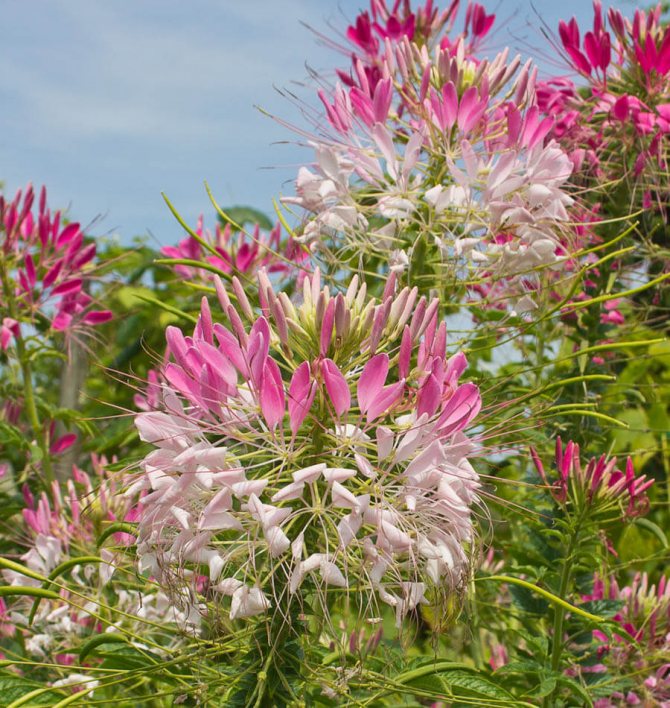

Despite the fact that the plant is unpretentious and non-capricious (the photo of a cleoma flower is shown above), the rules for growing everything must be observed:
- The plant should not be watered often and a lot. Because, although Africa and Latin America are considered the birthplace of cleoma, waterlogging can negatively affect the vitality of the flower. Strong moisture is needed exclusively in hot weather, in other cases it is not worth it.
- The plant should be fertilized at least twice a month. If the flower is weak, then its leaves can be treated with a nutrient solution. To prepare the solution, mix 3 liters of water and one tablespoon of fertilizer. Stir the solution and process it.
- To stimulate rapid growth and flowering, constant feeding should be carried out with appropriate preparations, which are presented in great abundance in stores today.
- Cleoma care also includes getting rid of weeds. Weeds should not be allowed to obstruct the growth of the flower. Weeding and loosening the soil will have a beneficial effect on plant growth.
- In the fall, the plants are harvested and the soil is prepared for the next season. Due to the ease of maintenance, such plants are often planted in summer cottages, flower beds near the house and in park areas.
Cleoma or Champagne Splash Flower
The cleoma flower or cleome is an annual plant that attracts flower growers with an attractive, original, luxurious appearance.
This is a real holiday and the best decoration for a flower garden.
The popular name of the plant is "champagne spray".
And it is enough just to look at its flowers, as it will immediately become clear why this name is used more often and is more popular than cleoma.
What does a champagne splash flower look like - a photo of a plant
The flower can grow up to one and a half meters in height.
Straight slender stems covered with sticky hairs stretch upward.
Light green foliage of various sizes is an incredible decoration for the plant.
Each leaf consists of several lobes and has a stipule with hard thorns at the base.
And a very interesting and peculiar aroma that attracts pollinating insects very much.
Champagne Splash Flower - Growing
The flower is grown from seed for seedlings, like most annuals.
Caring for him is quite traditional.
In order for the plant to develop well and bloom profusely, the growth temperature is recommended in the range of + 20C ... 22C.
Cleoma loves light very much, so she will like a sunny place more than a shaded one.
At the same time, it does not tolerate heat, so it is better to mulch the soil between the plants with a mountain immediately when planting seedlings.
As the soil dries up, the plant is moderately watered, fertilized twice a season.


champagne splash flower photo
By the way, "Spray of Champagne" can be grown in pots in room culture, creating suitable conditions.
The champagne splash flower decorates the room very well, and in the summer you can take it out to the balcony or take it to the country house.
Grow a champagne spray flower in your garden or windowsill because it is so beautiful.


The champagne splash flower is an annual that has been loved for its chic and attractive appearance. It is also called cleoma. This plant stands out for its special flowering: it is decorated with flowers first from the bottom, gradually reaching the top. To grow glue in your garden, you need to know some rules of care.
- Description of the plant
- Reproduction and planting
- Correct care
- Indoor flower "champagne splash"
The champagne spray flower belongs to the cleome family. The plant can grow up to 1.5 meters in height. It forms straight stems that cover slightly sticky hairs. The plant is decorated with light green foliage. It has different sizes. Each leaf is dissected into several lobes, and stipules with rigid thorns are formed at the base.
The plant got its name for a reason. When blooming occurs, flower petals, stamens and pistil appear, which together form an original composition that resembles a "spray of champagne".
Usually the inflorescences are pink or white, but varieties have appeared that are decorated with yellow and blue flowers. During the flowering period, cleoma emits an interesting aroma that not all people may like. In this way, the plant attracts insects that pollinate the flowers.


After the withering of the inflorescences, seed pods appear in their place, which are located on elongated legs. They diverge in different directions, resembling a large spider. In some countries, the plant is called a spider flower. Cleoma pleases with its flowering from the beginning of summer to the beginning of the first frost.
Reproduction and planting
Often, plant propagation is carried out using seeds, but sometimes ready-made seedlings are used for this. It can be planted immediately in open ground, but it should be done correctly. November-December is ideal for this. If planting is carried out at this time, then at the beginning of spring sprouts will already appear.
Growing a plant from seeds is easy. To do this, you should adhere to the following rules:
- A suitable container is prepared into which the soil is poured. The seeds are sown thickly. Experienced gardeners are advised to initially soak them for half a day in a solution of zircon, this will speed up the germination process.
- Some gardeners plant seeds in special peat tablets. In this case, when planting in open ground, the seedlings are not removed from the tablet.
- When the first leaves began to appear, then the sprouts should be transplanted into separate containers. They go deeper almost to the foliage itself. This must be done on time, otherwise you can injure the rhizome.
- If the crops do not develop well, then you can use complementary foods. To do this, you need to fertilize the soil.
Read also: Marinating chicken wings for barbecue
But don't overdo it with fertilizer. Small sprouts need regular watering, the soil should not dry out. But you don't need to overfill the plant either. When the seedlings take root well, then it is worthwhile to carry out abundant and careful watering. In order for the bush to grow lush and beautiful, then it is worth pinching the sprouts more than once. So that diseases are not disturbed on a young plant, watering is carried out with a solution of potassium permanganate.
In order for the "champagne spray" plant to develop well and delight its owners with flowering, it is necessary to create appropriate conditions and adhere to the rules of care. For the plant to grow normally, the temperature should be 15-20 degrees. Cleoma is a light-loving plant, so it is recommended to plant it in places that are well illuminated by the sun. The flower is not afraid of direct rays. But, if the weather is excessively hot, then it will be hard for the cleome. The plant must be watered moderately when the soil dries out.
Video about the cleoma flower:
In addition, it is recommended not to forget about loosening the soil. The flower loves medium humidity. To accelerate the growth of cleoma, experienced gardeners carry out top dressing. Complex fertilizers are suitable for this. A humate solution is of great benefit to a flower. The champagne spray plant reacts hard to transplant, so you should try not to disturb it. In rare cases, the flower suffers from disease. Before wintering, it is worth creating protection for her.
It is difficult for Cleome to endure the cold, as she loves warmth. In addition, southern countries are considered her homeland. Therefore, it develops well in an area that is well lit by the sun. This is all the rules regarding the care of this plant. It is considered unpretentious, able to easily take root in a variety of places. Adhering to all the recommendations, the plant will develop well, and later it will be decorated with beautiful inflorescences.
In addition, experienced gardeners strongly advise against flooding the plant. Otherwise, you may encounter gray rot or black leg. Cleoma is practically not affected by pests, since they are frightened off by its specific smell.
Indoor flower "champagne splash"
Often, the "champagne spray" flower is grown in gardens near the dacha. But some people calmly plant it in indoor pots and decorate the interior with them. To do this, it is enough to follow the rules of care. In addition, it is worth creating suitable conditions for the plant. It is not difficult to do this, and in return the cleoma will delight you with its amazing flowers.


In order for the plant to grow quietly indoors, it is worth bringing the growing conditions closer to the natural environment. It must be remembered that cleoma has related roots from tropical countries, so it should be placed on windowsills from the sunny side. In summer, temperature readings should not drop below 20 degrees. In winter, 15 degrees are permissible. To give the impression of tropical humidity, the plant should be systematically sprayed.
These are all the basic requirements for indoor growing. Planting and caring for a plant is no different if it developed outdoors. The main thing is that the soil is constantly moistened, and the air temperature is appropriate. Also, do not forget about feeding. So, the champagne spray plant is an excellent decoration for summer cottages.In addition, it can develop on the windowsill in the apartment.
Cleoma is an outlandish flower that is rare in our region. But whoever managed to bring it out in their flower beds will literally fall in love with this beautiful flower. And how could it be otherwise, because the Cleoma "Spray of Champagne" conquers with its lush greenery, massive stems, dense and expressive inflorescences. The plant prefers a temperate and subtropical climate. In the southern region, this crop is perennial, while in the rest of the Russian regions it is grown as an annual plant. Everyone can learn the rules for the care and cultivation of this flower.
Read also: Apple pie classic charlotte
Transplanting a flower
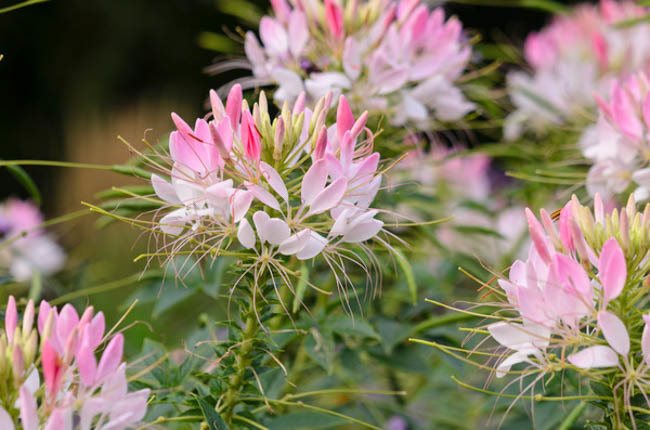

One of the prerequisites for care and growing rules is transplanting. If the reader looks above, he will see a photo of cleoma flowers, which are so mesmerizing. The bush grows quickly enough, because of this, it periodically has to be planted. Thanks to transplantation, the shrub becomes less susceptible to diseases. The flower can be transplanted after the first leaves appear on the stem. To transplant the soil, you need to fill it well with water and carefully pull out the root. Cleoma tolerates transplantation well, therefore, after a few days, the flower will regain its strength and will continue to grow.
Transplant rules
Indoor flowers of the hathiora normally perceive the transplant. Young cacti are transplanted annually, and older ones - every 2-3 years. It is best to do this immediately after flowering. A pot for a hatiora should be chosen wide, but not very deep, since the rhizome is located close to the surface. Pebbles, expanded clay or brick chips must be laid out at the bottom of the container so that excess water does not linger in the ground.
The soil for the hathiora should have a slightly acidic or neutral reaction. To compile it, the following are used:
- low-lying peat (2 parts);
- deciduous land (6 parts);
- sod land (1 part);
- coarse sand (2 parts);
- humus earth (4 parts).


Protection against insects and pests
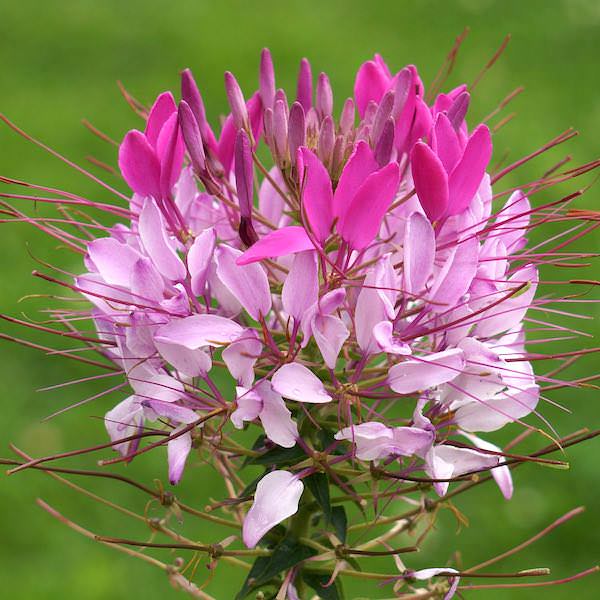

Unlike other types of flowers, if you look at the photo, the cleoma does not need special processing. Due to the specific smell, most insects and pests do not come close to the plant. Many gardeners use glue to protect their beds from insects and pests. Bushes are planted around the entire perimeter of the garden, thereby protecting the territory from small enemies. Insects such as mosquitoes, flies, aphids and other pests of cultivated plants are afraid of the strong aroma of the flower.
Despite its high protective characteristics, the plant is susceptible to some diseases: gray mold and powdery mildew. As a prevention of such diseases, you can try to regulate irrigation and watering. If the plant already has infected areas on the leaves, then "Fitolavin" and Bordeaux liquid will help get rid of the problem. The plant has good immunity to various kinds of diseases, however, improper watering can lead to a deterioration in the health of the plant and even death.
Description and features of cleoma
It is an annual or perennial herb or shrub up to 1.5 m in height. Rhizome and stems are powerful. Branched shoots, covered with short glandular hair.
Light malachite leaves are arranged alternately along the stem. They can be simple or complex, whole-edged, long, linear. One shoot grows from 5 to 7 pieces. The greens at the top are whole and fine. Some varieties have thorns on the underside of the foliage.
Flowers of regular shape, collected in racemes on the tops of tall peduncles. They have elongated stamens that resemble spider paws. Petals of various shades: snow-white, purple, sunny or lilac. Flowering can be observed throughout the summer.
The buds exude a specific aroma. It doesn't look like a flower and people don't like it. In the open air, however, it is almost elusive. But this smell scares off pests, but attracts natural pollinators - dwarf bats. After flowering, a unilocular pod-shaped polysperm begins to form, up to 3 mm long.
Seed collection


To plant new flowers next season, you need to collect seeds in this. The cleoma flower attracts many pollinating insects. In the place of flowering, a fruit appears, which in appearance resembles a pea or bean pod. There are seeds inside the pod. They must be collected immediately after ripening, when they turn yellowish or brown, and their diameter is 2 millimeters. The photo shows cleoma and if you look at the first 4 pictures from the right side, then its seeds are photographed on them.
The easiest way to collect seeds is to use a cloth or gauze. A fabric cover is put on the pod, into which the seeds fall out after ripening. You can also wear a sock as an alternative. When the seeds are harvested, the stem of the flower can be harvested and the soil can be prepared for the next planting.
Cleoma does not require special care or other requirements; such a plant can be grown by any novice and experienced gardener. With proper planting and seed collection, you can have an attractive flower bed every year.
Types and varieties of cleoma
Two varieties are cultivated: Hassler and Prickly. In their natural environment, they grow in the tropical areas of the South. America. On their basis, many hybrids have been bred with attractive and long flowering. They differ only in the color of the petals. The most beautiful varieties:
| Variety | Varieties | Coloring buds |
| Prickly | Cherry Queen | Purple or purple. |
| Helen Campbell | Snowy | |
| Rosakengen | Pudding | |
| Pink and Rose Queen | All pinkish shades. | |
| Violet Queen | Lilac ink. | |
| Golden Sparkler | Lemon golden | |
| Giant Pink Kyusen | Dirty pink | |
| Sparkler Lavender | Faint purple | |
| Hassler | Splashes of champagne | Light purple or pearl. |
| Kelly Rose | Pinkish lilac |
Specific uses of the plant
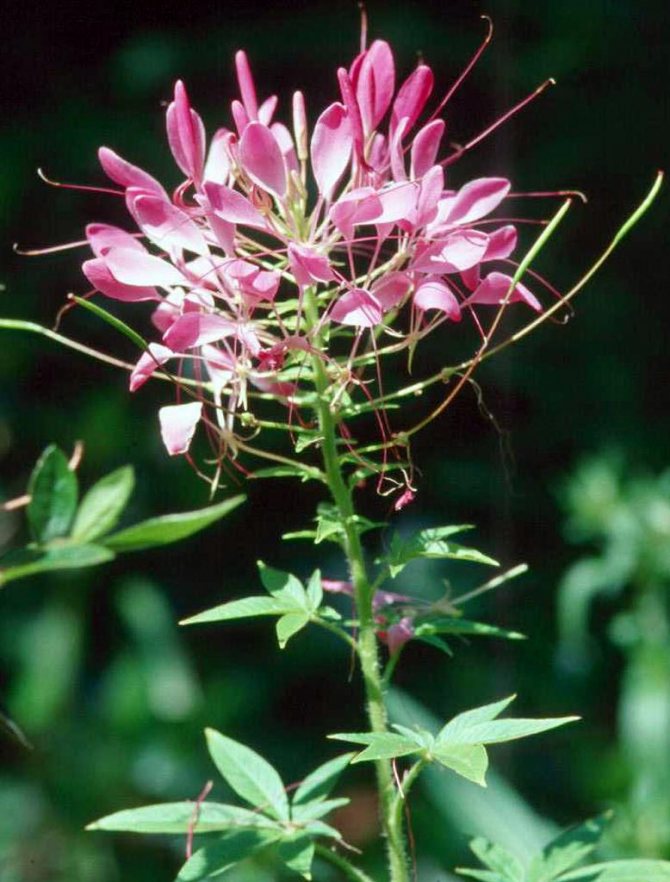

By using cleoma flowers, you can also protect your garden from pests and insects. In order not to use various chemicals and other poisons, it is much easier to plant a plant and harvest an environmentally friendly crop in the fall. If you look closely at the cleome, the photo of flowers is very bright and rich.
Due to its growth, which reaches one and a half meters, the plant can also be used as a living fence. A flowering fence will look beautiful, and as an addition, protect your site from flying and crawling insects. Such a hedge will put a certain emphasis on the landscape decor, which will ideally fit into the existing design.
Of course, keeping such a fragrant flower in the house is unlikely to work, but when it grows in the yard or in a flower bed, the spicy smell will fill the air masses and carry it over a large area. A beautiful flower can be a real addition to a yard flower bed or a separate flower grower.
Use in landscape design
Cleoma flower ("champagne spray") is widely used in the design of garden plots due to the ability to use it to decorate any barriers, structures and create all kinds of hedges. These flowers look spectacular against the background of bright green plants and among low-growing flowers.
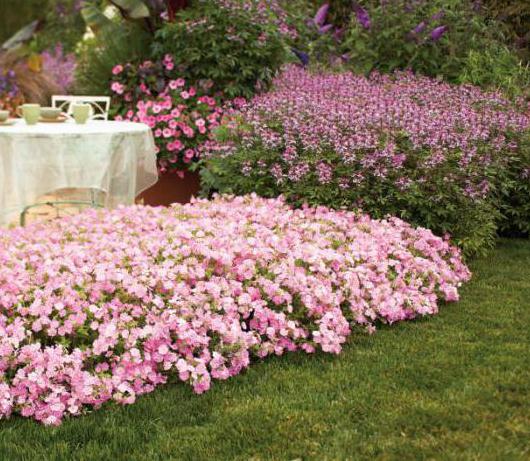

Cleoma looks very beautiful in composition with many plants - multi-colored phlox, rudbeckia, pink and white echinacea and other perennial and annual flowers. Due to the presence of thorns, it is not recommended to plant it in the foreground in flower beds or along paths.
A bouquet of these flowers can stand in a vase for up to 15 days. To do this, they are cut off in the evening and, after removing the thorns, they are left in the water in the fresh air overnight and only in the morning they are brought into the house.Cleoma will not only fill the room with a pleasant aroma, but also detoxify the air.
Biological description of the plant
In the middle lane, cleoma is grown as an annual and can reach a height of up to one meter. The stem of the flower is erect, bushy and does not break under the pressure of the wind. Two types of leaves are formed on one plant:
- Above, small and solid.
- Below are large and feathery, under which are stipules in the form of small spines.


The flowers are white, yellow, pink and purple in color, plants with an uneven color look especially unusual. Small flowers are collected in inflorescences up to 20 cm in diameter and each stem gives the impression of a whole bouquet. Cleoma blooms in June and continues to bloom until late autumn. There are so many buds that before frost all the flowers do not have time to open.
You can endlessly admire the glue, its flowering looks like a spray of champagne. In place of the faded buds, seed pods are formed, due to which the plant becomes even more like a spider. If you collect the seeds, then they will not lose their germination for about two years.
Caring for indoor roses at home

